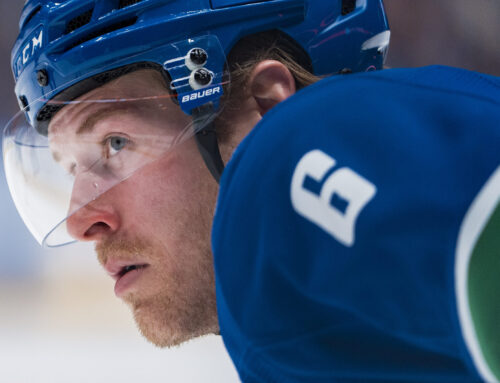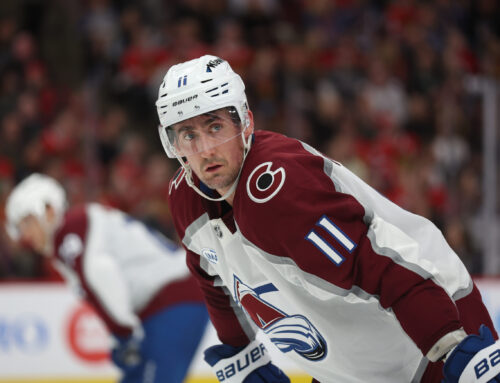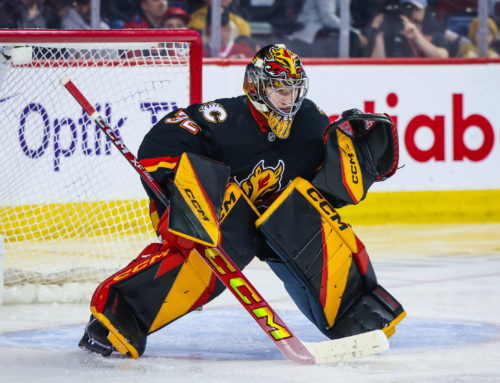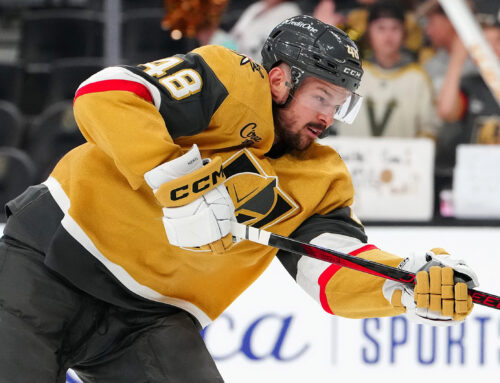
Doran continues his look through the West by focusing on right wingers this week.
There are not a ton of changes to the list of the best right wingers in the Western Conference, but there a few newcomers. This year focused a lot on usage as for a number of players on the list who they play with this could be a very important factor as to whether they actually fulfill the expectations that have been laid out for them. As always shots, quality as well as quantity, time on ice, both overall and specific to the power play, are very important factors. Which way a player is trending, and the factors behind that are also important, and played a big reason for Marian Hossa being slotted where he is.
Honourable Mentions:
Marian Hossa had a subpar shooting percentage for the second year in a row despite his shot rate and his scoring chance rate being virtually identical for the last three years. The Hawks need to add another higher-end talent to the line because Hossa is not the driving force he used to be.
One might expect Anthony Duclair to improve on his first season except that it is hard to see him repeating his 19% shooting percentage when he does not appear to be a pass first forward. Duclair managed to score 20 goals on just over 100 shots last year, so he will likely need to double the number of shots he takes to repeat his goal total from last year. When Duclair was on the ice the Coyotes had a 2.35 expected goals for per 60 minutes at even strength despite the Coyotes scoring 3.22 goals per 60 minutes. Duclair’s shots on goal improvement would end up keeping his stats at basically the same level they were last year.
The reason for optimism with Joonas Donskoi is that he gelled very well with Logan Couture at the end of last year and through the playoffs. The return of Couture to the Sharks’ lineup sparked a turnaround in Donskoi’s game and there is no reason to believe that they will not start the season together. Even as Donskoi’s seasons turned around the points did not necessarily come as the Donskoi-Couture combination did not started putting up points until the playoffs. The half-point per game that Donskoi averaged should be the minimum expectation of him in the new season.
Right Wings:
Nikolaj Ehlers
Nikolaj Ehlers performed outstandingly when he was placed on a scoring line as those lines averaged more than three goals per 60 minutes. However when he was placed on other lines, namely those with Chris Thorburn, he struggled mightily. In fact, while the Jets scored 2.60 goals per 60 minutes with Ehlers on the ice at even strength on the season, when Ehlers was on with Thorburn the Jets only scored 0.61 goals per minutes. It should then come as no shock that Ehlers only had two points in the 200 minutes he was on the ice with Thorburn; as a point of contrast he had 17 points in 500 minutes with Mark Scheifele.
Given how well Ehlers scored down the stretch of the season (16 points in the last 23 games), it seems a pretty safe assumption that Ehlers will play most of the season on a scoring line, and almost no time with Thorburn. A full season on a scoring line, along with usage approaching the 18+ minutes he was getting to end the season, will no doubt push Ehlers’ points total in the nieghbourhood of breaking 50 points. Add in the fact that there was little in Ehlers’ underlying numbers last season to suggest that it was a fluke (more than two shots per game and a shooting percentage under 10), and there is every reason to expect legitimate second line forward production from Ehlers all of this coming season.
Loui Eriksson
Eriksson gets this spot based on the assumption that his salary, as well as the dearth of talent on the Canucks will land him a spot on the Sedin line. While the Sedins are not what they used to be, they still generate shots at a high level. The Sedin line averaged more scoring chances per 60 minutes than any of the lines Eriksson played on in Boston, even though those lines took more shots.
Playing with the Sedins will not be enough to make the move from Boston to Vancouver a lateral one for Eriksson. First, his shooting percentage was three points higher than his career norm without any factors warranting an elevated percentage. Second, Eriksson had 17 points on the power play last season, as Boston was one of the better teams with the man advantage whereas Vancouver was a mess on the power play. Those 17 power play points marked the second highest single season total for Eriksson. Between the power play points and the shooting percentage Eriksson should drop by 10 points from last year’s 63 points. In the end there just is not enough of a difference between the Sedins and the line Eriksson played on in Boston to cover for the factors working against him.
James Neal
There was an improvement in production for Neal when he played with Ryan Johansen, but not in his underlying rate stats. Basically the Predators scored more when Neal and Johansen played together than when they did not, but that was from fewer shots. The Mike Fisher, Filip Forsberg and Neal combo averaged more shots, scoring chances, and expected goals per 60 minutes but only scored on 7.5% of their shots and therefore scored considerably fewer goals than the Johansen, Neal and Calle Jarnkrok combo. Thus, unlike Jarnkrok, whose numbers were considerably lower when on the ice without Johansen and Neal, Neal likely will not see a considerable bump from playing a full season with Johansen.
In order for Neal to get a big bump from playing with Johansen for a full year, the combo would need to score on 11% of their shots over a full season. That would be quite the feat, as no line that has played 300 or more minutes together has scored on 11% of their shots in twice in the last three years. The line will be fine but they will not be quite the offensive force as they were as they closed last season. They do not generate shots and scoring chances at a high enough rate to make them a high-end scoring line. Expect a drop of a goal per 60 minutes, which would basically be the rate at which the Predators scored with Neal on the ice last year.
Jordan Eberle
Eberle finished last season very well playing on a line with Connor McDavid, but it is not like their production together blew everyone else out of the water. Nail Yakupov had basically the same numbers with McDavid that Eberle did, while Patrick Maroon had much better numbers in a much smaller sample size. The argument for playing Eberle with McDavid instead of Yakupov is that the Eberle-McDavid combination generated considerably more shots and scoring chances per 60 minutes than when Yakupov played with McDavid.
Both combinations had a shooting percentage over 11%, although with Eberle on the ice the scoring chance rates were nearly 15 per 60 minutes. In fact lines that featured the McDavid-Eberle combination had the highest and fourth highest scoring chance per 60 minute rate of any line that played more than 100 minutes together. Their expected goal rates are similarly extreme, which is to say that as long as Eberle is playing with McDavid it is entirely reasonable to expect big things, however he was on for half as many per 60 minutes without McDavid. Eberle should get 60 points this year, but it is hard to put him higher until McDavid has made it through a full season.
Tyler Toffoli
Toffoli is now far and away the best winger on the Kings and likely the only one that is guaranteed a spot in the top six. While Teddy Purcell and Tanner Pearson will probably spend the bulk of the season in the top six, neither have played the percentage of the last two seasons in the top six that Toffoli has. Last year Toffoli played 930 of his 1070 minutes with one of Anze Kopitar or Jeff Carter. Milan Lucic was the only winger who played with one of the Kings’ top two centers more often.
Even if Lucic remained Toffoli has clearly cemented himself as a top six winger for the Kings. The big difference is that Lucic, Kopitar and Carter were the three Kings forwards who received the most minutes on the Kings power play. With Lucic having left to Edmonton, Toffoli is sure to get more power play time, and more time on the top unit, and along with that more than 11 points on the power play. The added power play time on its own is enough to push Toffoli over 60 points for the coming season even without any other improvement in Toffoli’s game.
Corey Perry
If there is a worrying factor in Perry’s game, it is the drastic drop in shots that he experienced last year. He went from a guy who averaged more than three shots per game over the bulk of his career to getting just over two and a half shots per game last year. He was able to still score more than 30 goals because of his traditionally high shooting percentage, as he is a player who is routinely sports a shooting percentage between 11 and 17 percent.
The Ducks are a much shallower team up front than they were last year, which may mean the reunion of the once mighty Ryan Getzlaf and Corey Perry dynamic duo. Perry had enough chemistry with Rickard Rakell that it should not matter either way which center he plays with, but the return of Randy Carlyle probably shifts the odds toward a dynamic duo reunion, given Carlyle’s usage of the two when he last coached the Ducks. Either way, it is status quo for Perry even if Getzlaf forgets how to score again.
Blake Wheeler
Wheeler is another player who is in a great situation as he found tremendous chemistry with Mark Scheifele even after his long time center Bryan Little went down with an injury. That should mean that he has success regardless of which center he plays with. Everyone likely remembers the rampage Wheeler and Scheifele went on to close the season, as the Jets scored over four goals per 60 minutes when they were on the ice together, but do not forget that he was on the ice for 2.8 goals per 60 minutes with Little before Little’s injury. His time with Little did not have the benefit of one player going on a torrid scoring spree, based on a shooting percentage over 20%, as his time with Scheifele did.
Just a reminder that every line combination this past year that featured Little and Wheeler together took at least 33 shots per 60 minutes. The advantage that Wheeler has with Scheifele is quality of opportunity the two generate together, meaning it basically amounts to a quality versus quantity argument. There is no downside for Wheeler regardless of which center (Little or Scheifele) he plays with this season. He will get his 65 points.
Joe Pavelski
Pavelski shows up as a right winger here because of the amount of time he plays with Joe Thornton. Yes he is technically a center, and yes he took more faceoffs than Thornton did, but Thornton plays more of the traditional center role. While seniority is not the best reason for making Pavelski a right wing it made more sense than calling Thornton a left wing or both centers.
As long as Thornton remains one of the best passers in the game, Pavelski will continue to rack up the big goal numbers. He has averaged just under 39 goals per year over the last three seasons on less than three shots per game. He has also had a shooting percentage of at least 14% in each of those three seasons. Pavelski is not just the latest Jonathan Cheechoo either, as he is an elite net front presence and possibly the best tipper of pucks in the game today. Chalk up your 35+ goals and 70+ points and take them to the bank.
Vladimir Tarasenko
Tarasenko is quickly becoming one of the most dangerous offensive players in the game today, and barring some fallout from his playoff spat with Ken Hitchcock, he will continue his ascension up the scoring ranks. Last year Tarasenko nearly hit the 300 shot mark as he averaged more than three shots per game for the second consecutive year. His 40 goals came off the increased number of shots as opposed to an elevated shooting percentage.
Furthermore, as an elite sniper there is absolutely no concern about Tarasenko’s high shooting percentage of around 14%, as a high shooting percentage is only a concern when it is an abnormality. There just is not anything to worry about here. Just sit back and watch him dazzle.
Patrick Kane
The arrival of Artemi Panarin in Chicago certainly kicked Kane’s game up a couple of notches. While Panarin’s arrival may have been the catalyst for Kane’s leap forward, make no mistake it is Kane that is driving the bus.
Kane saw two big changes to his production last year. The first was on the power play where he had a career-high 37 points, a level he only came close to in his second year in the league. The second was in his even strength assist rate. Neither of those are especially out of line given the addition of a high-end talent to his line.
The only possibly concerning aspect to Kane’s rise last season was his on-ice shooting percentage rising to over 10%. Expect something closer to his career on-ice shooting percentage of nine percent. That will correction will prevent him from getting 100 again but as long as he, Panarin and the power play are clicking breaking 90 is doable.
Stats in this article come from Corsica.hockey, stats.hockeyanalysis.com and hockeyreference.com.
9 Comments
Leave A Comment
You must be logged in to post a comment.





 FLA
FLA TOR
TOR CAR
CAR WPG
WPG DAL
DAL EDM
EDM WSH
WSH N.J
N.J

Spot on! to spice it a bit, lets add a rookie category and name P. Laine as best young right winger.
A rookie list would be good.
Tarasenko should get a boost with a healthy Schwartz on his line.
There will be a Western Conference newcomers column coming shortly. As for Tarasenko, Schwartz will help a little but Tarasenko generally plays with the best Blues have to offer and as such so Schwartz isn’t a huge upgrade as a linemate.
Is Ehlers really a RW? According to Frozen Pool he played most of is 15/16 shifts with Scheifele (C) and Wheeler (RW). As a Kyle Connor owner I hope he moves to the right side but I gotta think the Ehlers-Scheifele-Wheeler line is here to stay.
In the Guide I have Ehlers at RW. Laine is LW and I think Little/Wheeler will be with her. Which leaves Perreault-Scheifele-Ehlers. Great top six
I doubt Connor is on the team full-time this year
I guess with Laine joining the top-6 they can mix things up a bit. HFBoards projected lines and depth chart threads have Ehlers/Laine/Connor on the left but, after Wheeler, nobody special on the right. Fantrax has Ehlers/Laine at RW, Connor at LW. So who knows?
Yeah nobody knows for sure about the lines and that trio of E/S/W was pretty amazing. You’re right – nobody special on RW – after Wheeler is Stafford. So it makes sense to have Ehlers on the right as he can handle the move better than Laine or Perreault.
But I’m pretty positive Connor doesn’t make the team to start. Without him, they have 15 forwards (although Copp could be sent down). Connor would be LW though
Nvm.